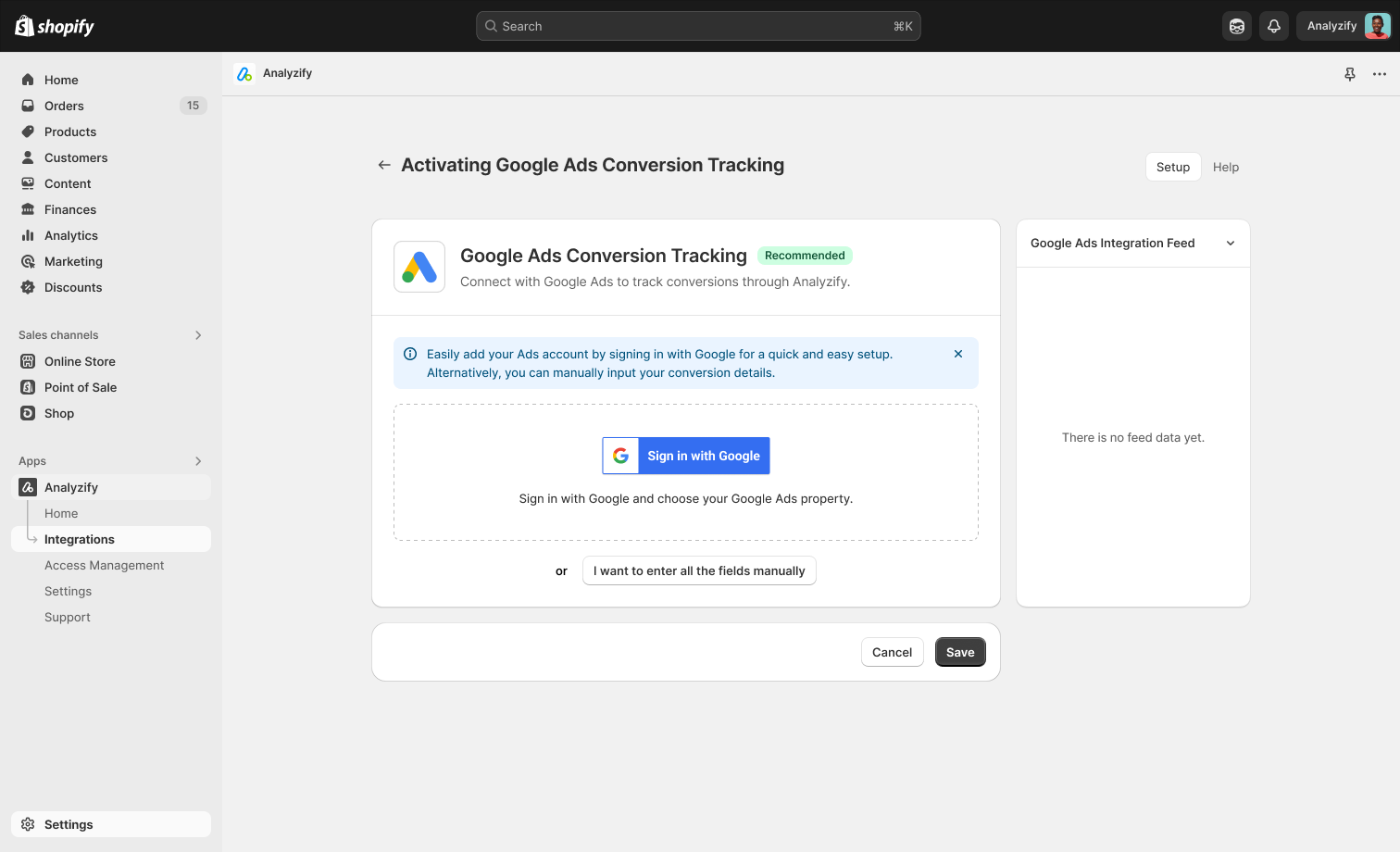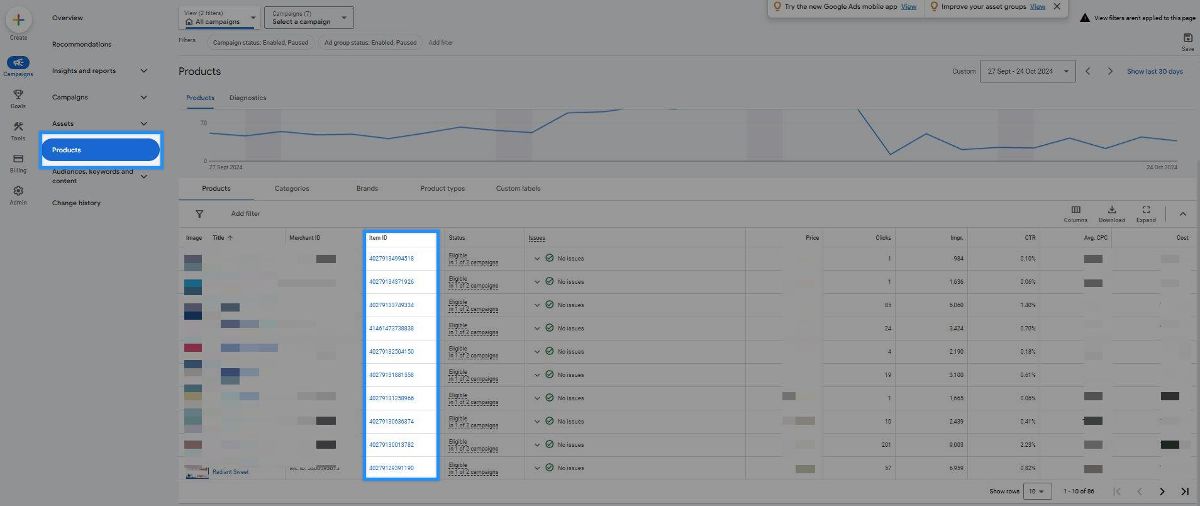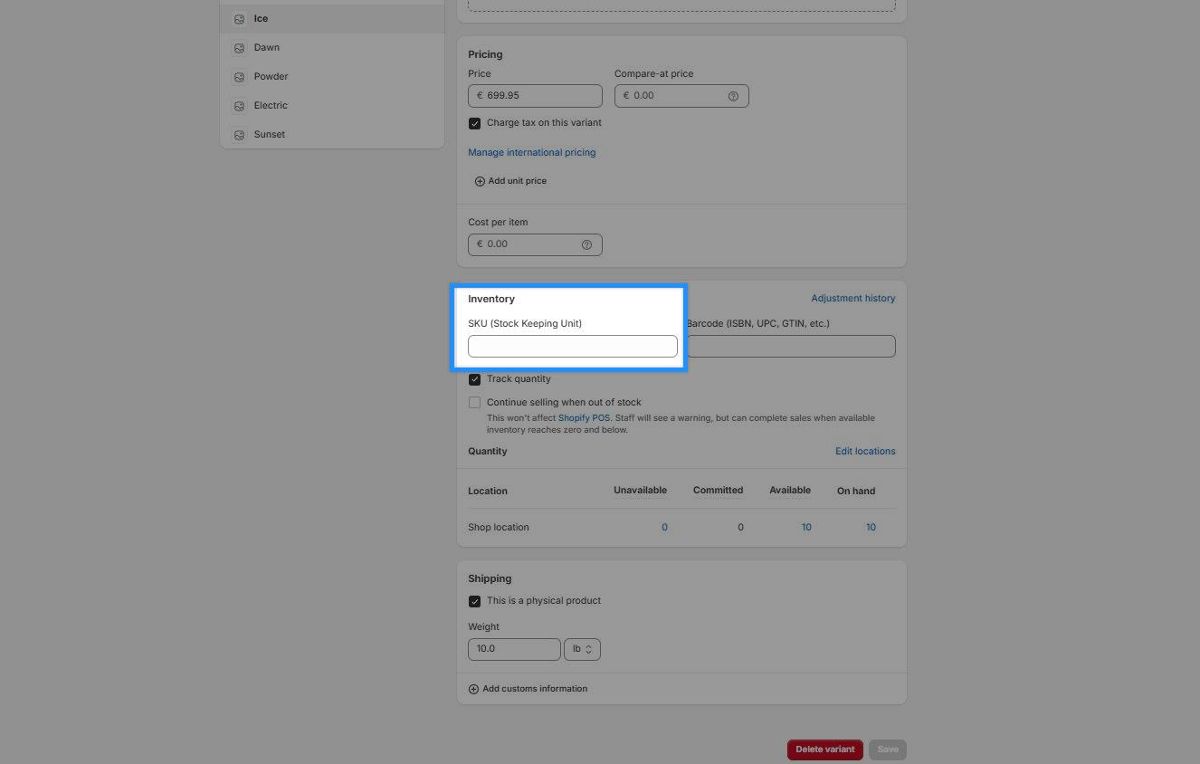Learn how to set up Google Ads conversion tracking with Analyzify's integration, which provides enhanced tracking capabilities by sending complete order-level and customer-level data to Google Ads.
This guide covers both Direct and customized (GTM) integration methods, essential Google Ads account settings, and expert recommendations to ensure optimal tracking performance.
Key Benefits
Our Google Ads integration provides:
- A user-friendly setup process that connects Analyzify with Google Ads without requiring technical expertise
- Enhanced conversion tracking that sends complete order-level and customer-level data to Google Ads with your conversions and events
- Automatic conversion tracking for measuring how your Google Ads campaigns drive sales
- Improved ROI through deeper Shopify and Google Ads integration that provides Google Ads with comprehensive data for campaign optimization
- Reliable data you can trust for making business decisions
- Complete conversion tracking setup covering four key actions: Purchase, Begin Checkout, Add to Cart, and Product Detail views
Google Ads Integration Methods with Analyzify
Analyzify offers two integration methods for Google Ads conversion tracking setup:
- Direct Integration
- Customized Integration (with GTM)
To understand the differences between these methods and choose the one that best suits your needs, please read our guide on choosing the right integration method .
⚠️ Important Notes Before Setup:
- Choose only one integration method. Do not activate both methods simultaneously.
- Enable the Analyzify app embed toggle on your live theme, otherwise completing the integration steps wouldn’t activate the conversion tracking.
- Don’t forget to connect your custom pixel.
1. Direct Integration Method
Implementing Google Ads conversion tracking through Direct Integration is the recommended method for most merchants due to its simpler setup and maintenance. Follow these steps to activate conversion tracking with Analyzify's direct integration.
Step 1: Choose Your Setup Method
Automated Setup (Recommended)

- Click "Sign in with Google"
- Select your Google account with Ads access
Note: Choose Manual Setup option if you prefer to enter your Conversion details manually. If you choose Automated Setup your conversion ID will be automatically populated.
Step 2: Authorization
- After selecting your Google account, complete the authorization steps
- Once you see the "Authorization Completed" message, click "Next Step" to proceed
Step 3: Configure Ads Settings Choose Your Ads Account
- Select your Google Ads account from the dropdown
- Click "Save" to complete this step
Note: If needed, click "Re-authorize" to authenticate with a different Google account
Step 4: Configure Conversion Details
Enter Conversion ID & Labels
To track your conversions, you'll need the Conversion ID and labels. If using manual setup or if fields are empty, here's how to find them:
- Go to Goals in the Google Ads interface
- Click your conversion action
- Find the Tag Setup section
- Click "Use Google Tag Manager"
- Copy your Conversion ID and conversion label.
Note: Both Conversion ID and Label must be entered correctly for tracking to work properly.

Important: If Tag Setup section is missing, your conversion isn't properly configured. Please use our " Create a New Google Ads Conversion " tutorial first.
Step 5: Select Item ID Format
First, locate your item IDs in Google Ads:
1- Go to Products in Google Ads
2- Click Products again to view your Item IDs
- Note: If Products isn't visible, click your PMax/shopping campaign first
Item IDs can also be located directly within the Google Merchant Center. For instructions on how to access and identify your item IDs through the Merchant Center, please refer to our guide .

After locating your item IDs in Merchant Center or Google Ads, you'll need to determine which IDs correspond to product IDs, variant IDs, or SKUs in your Shopify store. Here's how to identify them:
1) Go to Products in Shopify admin
2) Open any product with variants
3) Check the URL to find Product and Variant IDs

4) Look in the variant details to find the SKU

Once you've identified which ID type matches your Merchant Center feed, select that format in Analyzify.
Note: Make sure to use the same Item ID format you selected for Google Ads Dynamic Remarketing Tracking to maintain consistency.
After choosing your item ID:
- Select the conversions and provide the conversion labels you want to track through Analyzify
- Click "Next" to proceed to the next screen
- Copy the provided code block
- Go to Shopify Customer Events
- Click "Add custom pixel"
- Name it as "Analyzify 4.0 GAds Conv"
- Under Customer Privacy:
-
- Choose "Not required"
- Check "Data collected does not qualify as data sale"
- Paste the code block you copied into the Code field
- Click "Save" then select "Connect."
- Go back to the Analyzify app and mark "I added the code and connected the new pixel." as done.
- After a couple of minutes, your conversion tracking data flow is ready!
Note: If you already have an existing Google Ads Conversion Tracking pixel, make sure to disconnect and delete the old version before adding the new one to avoid duplication.
2. Customized (GTM) Integration Method
The Customized Integration method uses Google Tag Manager (GTM) to set up conversion tracking. Note that this method requires familiarity with GTM and additional technical setup compared to direct integration.
To proceed with the GTM integration, make sure you have a Google Tag Manager account and access to your Google Ads account. Then follow these steps:
- Access your Analyzify app and start your Customized (GTM) Integration
- Complete the storefront and custom pixel steps
- During the final setup stage, select "Google Ads Conversion Tracking" when choosing your desired integrations for the GTM container creation
- Download the generated container and import it to your Google Tag Manager account following our guide
- Add your conversion ID, conversion labels, and product ID format to the related variables
-
- For detailed variable customization instructions, visit our Customize and Import Analyzify Tags into GTM article .
- Test the configuration using GTM Preview mode.
- Publish your container once testing is complete
For detailed instructions and best practices, refer to our complete GTM setup guide .
Google Ads Account Settings
Our expert team checks these extra details when setting up Google Ads conversion tracking for our merchants:
- Ensure that you have only one primary conversion and set others as secondary. Because only primary conversions are included in campaign optimization. Secondary conversions are used for reporting and are not included in campaign optimization. If you are focusing your optimization efforts solely on purchases, we would recommend considering setting all other conversions as secondary. However, it's important to choose only ONE primary conversion for the purchase event.
- Set up your enhanced conversion setting based on your integration method:
-
- Direct Integration → Choose Google Tag
- Customized (GTM) Integration → Choose Google Tag Manager
Frequently Asked Questions (FAQs)
Warning messages for enhanced conversions typically appear when attempting to use enhanced conversions for events that don’t directly collect customer data (e.g., Add to Cart, Begin Checkout, Product Detail).
However, if your store allows users to log in during these steps, enhanced conversion data can be collected and pushed, provided the customer is logged in.
If the warning messages are related to these events and your users are not logged in, it’s not possible to collect and use enhanced conversion data for those actions. This functionality depends on capturing identifiable customer information, which is only available when the user is logged in.
To check if your conversions are receiving data, follow these steps:
- Google Ads Last Activity: Check the “Last Activity” date for the relevant conversion action in your Google Ads account. This date shows the last time data was received for that conversion.
- Cross-check with Shopify Orders: Compare the date of your most recent online order in Shopify with the “Last Activity” date in Google Ads. If these align, your setup is likely working as expected. However, if there’s a discrepancy, the issue might not be with the setup itself but rather with traffic or sales not originating from Google Ads.
It’s important to remember that discrepancies can occur due to various reasons, such as:
- Orders coming from other channels (not Google Ads).
- Attribution delays or differences in how Shopify and Google Ads measure conversions.
- Setup errors or untagged pages where events aren’t being tracked.
Need Additional Help?
You can create a service ticket and ask for our expert team's help.
